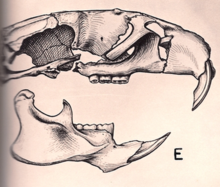Ekbletomys hypenemus
| "Ekbletomys hypenemus" | |
|---|---|
 |
|
| Side view of the holotype skull | |
| Scientific classification (unresolved) | |
| Kingdom: | Animalia |
| Phylum: | Chordata |
| Class: | Mammalia |
| Order: | Rodentia |
| Family: | Cricetidae |
| Subfamily: | Sigmodontinae |
| Tribe: | Oryzomyini |
| Genus: |
"Ekbletomys" Ray, 1962 (unavailable name) |
| Species: | "E. hypenemus" |
| Binomial name | |
|
"Ekbletomys hypenemus" (Ray, 1962) (unavailable name) |
|
 |
|
| Location of Antigua and Barbuda, where "Ekbletomys hypenemus" was endemic. | |
"Ekbletomys hypenemus" is an extinctoryzomyine rodent from the islands of Antigua and Barbuda, Lesser Antilles. It was described as the only species of the subgenus "Ekbletomys" of genus Oryzomys in a 1962 Ph.D. thesis, but that name is not available under the International Code of Zoological Nomenclature and the species remains formally unnamed. It is currently referred to as "Ekbletomys hypenemus" in the absence of a formally available name. The species is now thought to be extinct, but association with introduced Rattus indicates that it survived until after 1500 CE on Antigua.
It is known from abundant skeletal elements, which document it as the largest known oryzomyine, on par with Megalomys desmarestii, another Antillean endemic. Its morphological features indicate that it is distinct from Megalomys, which includes various other Antillean oryzomyines, and derives from a separate colonization of the Lesser Antilles by oryzomyines. In the original description, it was placed close to a species now placed in Nephelomys, but its relationships have not been studied since.
Remains of "Ekbletomys" were first found on Barbuda in the summer of 1958 and subsequently on Antigua in 1961. In his 1962 Ph.D. thesis at Harvard University, paleontologist Clayton E. Ray described them as a new species, Oryzomys hypenemus, which he considered distinctive enough to merit its own subgenus, Ekbletomys. The specific name, hypenemus, is derived from ύπηνεμος (hypênemos), which means "leeward" in Ancient Greek and refers to the species' distribution in the Leeward Islands, and the subgeneric name, Ekbletomys, combines Ancient Greek εκβλητος (ekblêtos) "cast up" and μυς (mus) "mouse", referring to the way "Ekbletomys" probably reached its islands. Because Ray's thesis does not meet the definition of a "published work" in the International Code of Zoological Nomenclature, both new names proposed by Ray are not available and cannot be used in formal zoological nomenclature. The name has rarely been used in the literature on Antillean oryzomyines since, and no formal description has been published; thus, the animal still lacks a formally available name.
...
Wikipedia
